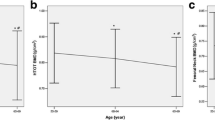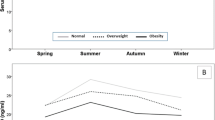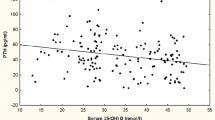Abstract
Summary
This study sought to determine the minimal serum 25-hydroxyvitamin D [25(OH)D] concentration required to maintain bone health in postmenopausal women with low bone mass. A serum 25(OH)D concentration of 20 ng/mL rather than 30 ng/mL was appropriate for bone health.
Introduction
There is no consensus on the minimal serum 25-hydroxyvitamin D [25(OH)D] concentration required to maintain bone health. The aim of this study was to investigate the relationship between 25(OH)D measured via liquid chromatography-mass spectrometry (LC–MS/MS), which is the current gold standard, and biochemical markers of bone turnover, PTH, and bone mineral densitometry (BMD).
Methods
The medical records of 750 postmenopausal women newly diagnosed with osteoporosis or osteopenia at Samsung Medical Center from 2009 to 2014 were investigated. Subjects were divided into four groups according to serum 25(OH)D concentration: <10, 10–20, 20–30, and ≥30 ng/mL. Serum concentrations of bone-specific alkaline phosphatase (BS-ALP), carboxy-terminal cross-linking telopeptide of type 1 collagen (CTx), intact PTH (iPTH), and BMD were compared among the four groups using analysis of covariance. Thresholds of 25(OH)D were then assessed using spline plots and locally weighted regression smoothing (LOESS) plots.
Results
25(OH)D was negatively correlated with serum BS-ALP, CTx, and iPTH. Only femur neck and total femur BMD had significant positive relationships with 25(OH)D. Cutoff values of 11.9 and 9.7 ng/mL were estimated from the spline plots of femur neck and total femur BMD, respectively. For iPTH, the LOESS plot showed a steep decrease to a serum 25(OH)D concentration of about 20 ng/mL, followed by a plateau.
Conclusions
According to this study, a serum 25(OH)D concentration of 20 ng/mL, rather than 30 ng/mL, was appropriate for bone health.


Similar content being viewed by others
References
Holick MF (2007) Vitamin D deficiency. N Engl J Med 357(3):266–281. doi:10.1056/NEJMra070553
Lips P (2001) Vitamin D deficiency and secondary hyperparathyroidism in the elderly: consequences for bone loss and fractures and therapeutic implications. Endocr Rev 22(4):477–501. doi:10.1210/edrv.22.4.0437
Holick MF, Binkley NC, Bischoff-Ferrari HA, Gordon CM, Hanley DA, Heaney RP, Murad MH, Weaver CM, Endocrine S (2011) Evaluation, treatment, and prevention of vitamin D deficiency: an Endocrine Society clinical practice guideline. J Clin Endocrinol Metab 96(7):1911–1930. doi:10.1210/jc.2011-0385
Dawson-Hughes B, Mithal A, Bonjour JP, Boonen S, Burckhardt P, Fuleihan GE, Josse RG, Lips P, Morales-Torres J, Yoshimura N (2010) IOF position statement: vitamin D recommendations for older adults. Osteoporos Int 21(7):1151–1154. doi:10.1007/s00198-010-1285-3
Hanley DA, Cranney A, Jones G, Whiting SJ, Leslie WD, Cole DE, Atkinson SA, Josse RG, Feldman S, Kline GA, Rosen C, Guidelines Committee of the Scientific Advisory Council of Osteoporosis C (2010) Vitamin D in adult health and disease: a review and guideline statement from osteoporosis Canada. CMAJ 182(12):E610–E618. doi:10.1503/cmaj.080663
Ross AC, Manson JE, Abrams SA, Aloia JF, Brannon PM, Clinton SK, Durazo-Arvizu RA, Gallagher JC, Gallo RL, Jones G, Kovacs CS, Mayne ST, Rosen CJ, Shapses SA (2011) The 2011 report on dietary reference intakes for calcium and vitamin D from the Institute of Medicine: what clinicians need to know. J Clin Endocrinol Metab 96(1):53–58. doi:10.1210/jc.2010-2704
Aspray TJ, Bowring C, Fraser W, Gittoes N, Javaid MK, Macdonald H, Patel S, Selby P, Tanna N, Francis RM, National Osteoporosis S (2014) National Osteoporosis Society vitamin D guideline summary. Age Ageing 43(5):592–595. doi:10.1093/ageing/afu093
Rizzoli R, Boonen S, Brandi ML, Bruyere O, Cooper C, Kanis JA, Kaufman JM, Ringe JD, Weryha G, Reginster JY (2013) Vitamin D supplementation in elderly or postmenopausal women: a 2013 update of the 2008 recommendations from the European Society for Clinical and Economic Aspects of osteoporosis and osteoarthritis (ESCEO). Curr Med Res Opin 29(4):305–313. doi:10.1185/03007995.2013.766162
(2003) Prevention and management of osteoporosis. World Health Organ Tech Rep Ser 921:1–164. back cover
Su Z, Narla SN, Zhu Y (2014) 25-hydroxyvitamin D: analysis and clinical application. Clin Chim Acta 433:200–205. doi:10.1016/j.cca.2014.03.022
de la Hunty A, Wallace AM, Gibson S, Viljakainen H, Lamberg-Allardt C, Ashwell M (2010) UK Food Standards Agency workshop consensus report: the choice of method for measuring 25-hydroxyvitamin D to estimate vitamin D status for the UK National Diet and nutrition survey. Br J Nutr 104(4):612–619. doi:10.1017/S000711451000214X
Singh RJ, Taylor RL, Reddy GS, Grebe SK (2006) C-3 epimers can account for a significant proportion of total circulating 25-hydroxyvitamin D in infants, complicating accurate measurement and interpretation of vitamin D status. J Clin Endocrinol Metab 91(8):3055–3061. doi:10.1210/jc.2006-0710
Carter GD, Jones JC (2009) Use of a common standard improves the performance of liquid chromatography-tandem mass spectrometry methods for serum 25-hydroxyvitamin-D. Ann Clin Biochem 46(Pt 1):79–81. doi:10.1258/acb.2008.008135
Hui SL, Gao S, Zhou XH, Johnston CC Jr, Lu Y, Gluer CC, Grampp S, Genant H (1997) Universal standardization of bone density measurements: a method with optimal properties for calibration among several instruments. J Bone Miner Res 12(9):1463–1470. doi:10.1359/jbmr.1997.12.9.1463
Lu Y, Fuerst T, Hui S, Genant HK (2001) Standardization of bone mineral density at femoral neck, trochanter and Ward’s triangle. Osteoporos Int 12(6):438–444. doi:10.1007/s001980170087
Kuchuk NO, Pluijm SM, van Schoor NM, Looman CW, Smit JH, Lips P (2009) Relationships of serum 25-hydroxyvitamin D to bone mineral density and serum parathyroid hormone and markers of bone turnover in older persons. J Clin Endocrinol Metab 94(4):1244–1250. doi:10.1210/jc.2008-1832
Kuchuk NO, van Schoor NM, Pluijm SM, Chines A, Lips P (2009) Vitamin D status, parathyroid function, bone turnover, and BMD in postmenopausal women with osteoporosis: global perspective. J Bone Miner Res 24(4):693–701. doi:10.1359/jbmr.081209
Barake M, Daher RT, Salti I, Cortas NK, Al-Shaar L, Habib RH, Fuleihan Gel H (2012) 25-hydroxyvitamin D assay variations and impact on clinical decision making. J Clin Endocrinol Metab 97(3):835–843. doi:10.1210/jc.2011-2584
Farrell CJ, Martin S, McWhinney B, Straub I, Williams P, Herrmann M (2012) State-of-the-art vitamin D assays: a comparison of automated immunoassays with liquid chromatography-tandem mass spectrometry methods. Clin Chem 58(3):531–542. doi:10.1373/clinchem.2011.172155
Lai JK, Lucas RM, Banks E, Ponsonby AL (2012) Variability in vitamin D assays impairs clinical assessment of vitamin D status. Intern Med J 42(1):43–50. doi:10.1111/j.1445-5994.2011.02471.x
Binkley N, Wiebe D (2013) Clinical controversies in vitamin D: 25(OH)D measurement, target concentration, and supplementation. J Clin Densitom 16(4):402–408. doi:10.1016/j.jocd.2013.08.006
Wallace AM, Gibson S, de la Hunty A, Lamberg-Allardt C, Ashwell M (2010) Measurement of 25-hydroxyvitamin D in the clinical laboratory: current procedures, performance characteristics and limitations. Steroids 75(7):477–488. doi:10.1016/j.steroids.2010.02.012
Fraser WD, Milan AM (2013) Vitamin D assays: past and present debates, difficulties, and developments. Calcif Tissue Int 92(2):118–127. doi:10.1007/s00223-012-9693-3
Granado-Lorencio F, Mosteiro JS, Herrero-Barbudo C, Navarro ED, Blanco-Navarro I, Perez-Sacristan B (2010) 25-OH-vitamin D assay variation and subject management in clinical practice. Clin Biochem 43(4–5):531–533. doi:10.1016/j.clinbiochem.2009.11.020
Binkley N, Krueger D, Cowgill CS, Plum L, Lake E, Hansen KE, DeLuca HF, Drezner MK (2004) Assay variation confounds the diagnosis of hypovitaminosis D: a call for standardization. J Clin Endocrinol Metab 89(7):3152–3157. doi:10.1210/jc.2003-031979
Bischoff-Ferrari HA, Willett WC, Orav EJ, Lips P, Meunier PJ, Lyons RA, Flicker L, Wark J, Jackson RD, Cauley JA, Meyer HE, Pfeifer M, Sanders KM, Stahelin HB, Theiler R, Dawson-Hughes B (2012) A pooled analysis of vitamin D dose requirements for fracture prevention. N Engl J Med 367(1):40–49. doi:10.1056/NEJMoa1109617
Chapuy MC, Preziosi P, Maamer M, Arnaud S, Galan P, Hercberg S, Meunier PJ (1997) Prevalence of vitamin D insufficiency in an adult normal population. Osteoporos Int 7(5):439–443
Bischoff-Ferrari HA, Willett WC, Wong JB, Stuck AE, Staehelin HB, Orav EJ, Thoma A, Kiel DP, Henschkowski J (2009) Prevention of nonvertebral fractures with oral vitamin D and dose dependency: a meta-analysis of randomized controlled trials. Arch Intern Med 169(6):551–561. doi:10.1001/archinternmed.2008.600
Sai AJ, Walters RW, Fang X, Gallagher JC (2011) Relationship between vitamin D, parathyroid hormone, and bone health. J Clin Endocrinol Metab 96(3):E436–E446. doi:10.1210/jc.2010-1886
Priemel M, von Domarus C, Klatte TO, Kessler S, Schlie J, Meier S, Proksch N, Pastor F, Netter C, Streichert T, Puschel K, Amling M (2010) Bone mineralization defects and vitamin D deficiency: histomorphometric analysis of iliac crest bone biopsies and circulating 25-hydroxyvitamin D in 675 patients. J Bone Miner Res 25(2):305–312. doi:10.1359/jbmr.090728
Heaney RP, Dowell MS, Hale CA, Bendich A (2003) Calcium absorption varies within the reference range for serum 25-hydroxyvitamin D. J Am Coll Nutr 22(2):142–146
Bischoff-Ferrari HA, Willett WC, Wong JB, Giovannucci E, Dietrich T, Dawson-Hughes B (2005) Fracture prevention with vitamin D supplementation: a meta-analysis of randomized controlled trials. JAMA 293(18):2257–2264. doi:10.1001/jama.293.18.2257
Hansen KE, Johnson RE, Chambers KR, Johnson MG, Lemon CC, Vo TN, Marvdashti S (2015) Treatment of vitamin D insufficiency in postmenopausal women: a randomized clinical trial. JAMA Intern Med 175(10):1612–1621. doi:10.1001/jamainternmed.2015.3874
Bischoff-Ferrari HA, Dawson-Hughes B, Orav EJ, Staehelin HB, Meyer OW, Theiler R, Dick W, Willett WC, Egli A (2016) Monthly high-dose vitamin D treatment for the prevention of functional decline: a randomized clinical trial. JAMA Intern Med 176(2):175–183. doi:10.1001/jamainternmed.2015.7148
Fan B, Lu Y, Genant H, Fuerst T, Shepherd J (2010) Does standardized BMD still remove differences between Hologic and GE-lunar state-of-the-art DXA systems? Osteoporos Int 21(7):1227–1236. doi:10.1007/s00198-009-1062-3
Silverberg SJ, Shane E, de la Cruz L, Dempster DW, Feldman F, Seldin D, Jacobs TP, Siris ES, Cafferty M, Parisien MV et al (1989) Skeletal disease in primary hyperparathyroidism. J Bone Miner Res 4(3):283–291. doi:10.1002/jbmr.5650040302
Suzuki Y, Whiting SJ, Davison KS, Chilibeck PD (2003) Total calcium intake is associated with cortical bone mineral density in a cohort of postmenopausal women not taking estrogen. J Nutr Health Aging 7(5):296–299
Ooms ME, Roos JC, Bezemer PD, van der Vijgh WJ, Bouter LM, Lips P (1995) Prevention of bone loss by vitamin D supplementation in elderly women: a randomized double-blind trial. J Clin Endocrinol Metab 80(4):1052–1058. doi:10.1210/jcem.80.4.7714065
Burger H, van Daele PL, Algra D, van den Ouweland FA, Grobbee DE, Hofman A, van Kuijk C, Schutte HE, Birkenhager JC, Pols HA (1994) The association between age and bone mineral density in men and women aged 55 years and over: the Rotterdam study. Bone Miner 25(1):1–13
Acknowledgements
The authors would like to thank Yaeji Lim and Kiyoun Kim of the Biostatistics and Clinical Epidemiology Center, Samsung Medical Center for statistical assistance.
Author information
Authors and Affiliations
Corresponding author
Ethics declarations
Conflicts of interest
None.
Rights and permissions
About this article
Cite this article
Lee, D.Y., Jee, J.H., Cho, Y.Y. et al. Serum 25-hydroxyvitamin D cutoffs for functional bone measures in postmenopausal osteoporosis. Osteoporos Int 28, 1377–1384 (2017). https://doi.org/10.1007/s00198-016-3892-0
Received:
Accepted:
Published:
Issue Date:
DOI: https://doi.org/10.1007/s00198-016-3892-0




